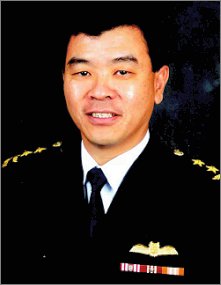Maj Gen Lim Kim Choon, head of the
 What roles will the new fleet of F-15SG fighters play?
What roles will the new fleet of F-15SG fighters play?
The F-15SG can conduct a full range of missions ranging from air defence to strike operations.
What kind of advanced avionics, radar and weapon systems will the F-15SG be equipped with and how does this represent an improvement over your current fighter capabilities?
What are your expectations for the Joint Strike Fighter (JSF) programme?
What roles will the JSF play compared with the F-15SG?
We will need to do a full assessment of the JSF’s capabilities first.
If the JSF is delayed, will the RSAF consider acquiring more than 20 F-15SGs?
We will evaluate all possible options.
Are there any plans to upgrade the RSAF's Lockheed Martin F-16 fleet?
There are currently no plans to upgrade our F-16 fleet as their present capability meets our operational requirements. RSAF will continue to monitor technological advancements and operational requirements to ensure that our F-16s will effectively fulfil their intended missions.
How are the new Block 52 F-16s performing and are there any considerations to acquire more of such aircraft?
We are satisfied with the performance of the Block 52 F-16D. With the improved attack avionics, the Block 52 F-16D fighters are able to achieve higher combat effectiveness. Currently, there are no plans to acquire more of such aircraft.
When will
We sent an evaluation team to study and assess all four platforms in the latter half of 2005. Asian Aerospace presents an opportunity to conduct an update on these evaluations. As part of the process, we are expecting to receive tenders just before AA2006.
When do you plan to select a new primary trainer and when will the S211s be phased out?
We plan to select the new primary trainer by the third quarter of this year. The implementation of the programme would be planned to allow the gradual phasing out of the S211s, and we should expect this to take place in about two years’ time.
What are RSAF looking for in a new primary trainer and how many aircraft will be leased?
The key objective of basic training has not changed and the new trainer must have good handling qualities to allow a trainee with little flight experience to quickly learn how to control the aircraft. In addition, the trainer should have modern avionics to introduce systems management to future pilots. Finally, we seek an aircraft that allows the handling of some training from our advanced training platforms. The fleet size will be proposed by the bidders to meet the requirements we have outlined.
Why has
The reasons for pursuing a private-public partnership [PPP] are twofold. First, by leveraging on commercial efficiencies and practices, costs can be lowered. Innovative solutions like joint operations with other customers would not be feasible with traditional procurement methodologies. Second, we are able to better distribute the risks. For example, issues of technological obsolescence are risks that are effectively transferred to the private sector, while the RSAF retains certain risks better borne by the government.
When will
The RFI for the advanced jet trainers replacement will be issued in the middle to end of 2006, and the ITT will follow approximately a year later.
How many new advanced jet trainers does
Again, the RSAF will state our requirements to the vendors, who will then propose the fleet size.
Will the new advanced trainers also be leased or do you plan instead to purchase them directly from the manufacturer?
This has yet to be decided. The RSAF will conduct a feasibility study based on the RFI responses, which would then allow us to determine if we want to lease or purchase directly from the manufacturer.
What is the retirement schedule for the TA-4SUs and will the replacements also be based in
The tentative plan is to replace the TA-4SUs in
When will the six new Sikorsky S-70s be delivered and how is the RSAF now preparing for ship-based operations?
We expect delivery in 2009. The RSAF is already familiar with ship-based helicopter operations as our Super Puma helicopters conduct regular training with the RSN. We should be able to operationalise the S-70 for naval operations fairly quickly.
What role will these new S-70 helicopters have?
The S-70 helicopters' primary roles would be in the area of anti-surface and anti-subsurface warfare.
What kinds of upgrade are planned for the RSAF's Lockheed C-130 fleet?
We are looking at possible avionics upgrades.
What new AEW and MPA aircraft is
We are assessing various options to replace the E-2Cs, which are due to retire at the turn of the decade. The MPA is still effective in carrying out maritime surveillance missions, and there are no plans to replace them.
What UAVs are
The potential of unmanned warfare is promising and the RSAF is keeping abreast of technological advancements in this area to see how we can achieve cost effective solutions for some of the mission requirements.
Source: Flight Daily News























